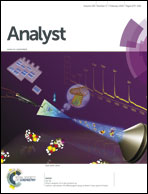High finesse optical cavity coupled with a quartz-enhanced photoacoustic spectroscopic sensor
Abstract
An ultra-sensitive and selective quartz-enhanced photoacoustic spectroscopy (QEPAS) combined with a high-finesse cavity sensor platform is proposed as a novel method for trace gas sensing. We call this technique Intra-cavity QEPAS (I-QEPAS). In the proposed scheme, a single-mode continuous wave quantum cascade laser (QCL) is coupled into a bow-tie optical cavity. The cavity is locked to the QCL emission frequency by means of a feedback-locking loop that acts directly on a piezoelectric actuator mounted behind one of the cavity mirrors. A power enhancement factor of ∼240 was achieved, corresponding to an intracavity power of ∼0.72 W. CO2 was selected as the target gas to validate our sensor. For the P(42) CO2 absorption line, located at 2311.105 cm−1, a minimum detection limit of 300 parts per trillion by volume at a total gas pressure of 50 mbar was achieved with a 20 s integration time. This corresponds to a normalized noise equivalent absorption of 3.2 × 10−10 W cm−1 Hz−1/2, comparable with the best results reported for the QEPAS technique on much faster relaxing gases. A comparison with standard QEPAS performed under the same experimental conditions confirms that the I-QEPAS sensitivity scales with the intracavity laser power enhancement factor.


 Please wait while we load your content...
Please wait while we load your content...